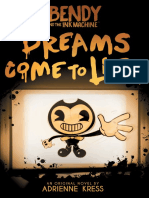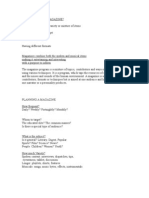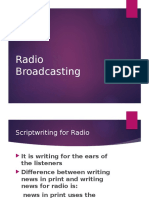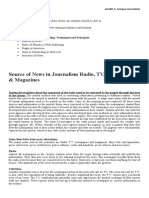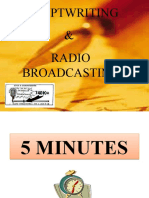Journalism Terminology
Journalism Terminology
Uploaded by
shakhenCopyright:
Available Formats
Journalism Terminology
Journalism Terminology
Uploaded by
shakhenCopyright
Available Formats
Share this document
Did you find this document useful?
Is this content inappropriate?
Copyright:
Available Formats
Journalism Terminology
Journalism Terminology
Uploaded by
shakhenCopyright:
Available Formats
Journalism Terminology
Be able to define the following terms and apply them to print, broadcast, and web journalism.
1. angle - The approach or focus of a story. 2. assignment - A job given to a journalist by an editor. 3. attribution - to mention the original source of material (usually pertaining to a quote from a copyrighted source) 4. beat - The area or subject that a reporter regularly covers. 5. bias - Where the article shows favoritism or disapproval toward a subject in an article 6. blog - An online commentary or diary often written by individuals about hobbies or areas of specialist interest. 7. blogger - A person who writes a blog. 8. blurb - Brief introduction to the writer, usually following the headline. 9. break a story (breaking news) - When a story is first published or aired. 10. 11. broadcast - communicating using radio and/or TV. byline - A journalists name at the beginning of a story.
12. caption - Text printed below a picture used to describe it and who took it. Sometimes called a cutline. 13. citation - To mention the source of original material or quotes. 14. column - A regular feature often on a specific topic, written by the same person who is known as a columnist. 15. copy - Main text of a story.
16. correspondent (or on-the-scene reporter) is a journalist or commentator who contributes reports to a newspaper, radio, or television news from a remote, often distant, location. A foreign correspondent is in a foreign country. 17. cover story - Leading story used on front cover.
18. credibility - A good reporter will consider the credibility, or believability, of any source of information.
19. credit a source - A reporter must always indicate where the information in the story came from. If the source wants to remain anonymous, the reporter should credit the source as in the following example: "The President is involved in secret meetings with France," said a source close to the White House who spoke on condition of anonimity. 20. crosshead - A few words used to break up large amounts of text, normally taken from the main text. Typically used in interviews. 21. dateline - The place-names at the beginning of a story that tell the reader where the story occurred. A dateline includes the name of a city or town, and sometimes the country. Before high-speed transmission of data, it also included the date, which is why it is called a "dateline." 22. deadline - The time at which an editor requests a journalists to finish an assignment. 23. defamation - Information that is written by one person which damages another person reputation. 24. edit - the process of reviewing a news story, revising the writing and checking it for mistakes before it is published or broadcast. 25. editor - Someone who prepares material for print or broadcast.
26. editorial - an opinion column written by the editor of a newspaper. 27. editorialize - To write in an opinionated way. 28. endnote - Text written at the end of an article stating the authors credentials. 29. 30. feature - A longer, more in-depth article. follow-up - An update on a previous story.
31. freelancer - Someone that works alone, usually on a contract-to-contract basis. 32. 33. hard copy - When the article is printed out on paper. headline - The main title of the article.
34. hearsay - When someone relates a story without evidence to back it up. 35. journalist - Someone who writes, researches and reports news, or works on the production of a publication. Sometimes shortened to journo, hack or scribe. 36. 37. kill - To cancel or delete a story. layout -(noun) How the page is designed and formatted.
38. lead (also: lede) - the opening sentence or two of an article that contains who, what, where, when, why/how. 39. leading questions - A question that contains the predicted answer within the question. 40. libel - A case for defamation. Defendent would need to show claims were true, fair comment or an accurate record of parliamentary or court proceedings. 41. masthead - Main title section and name at the front of a publication.
42. mug shot - Police photograph of someone who has been booked on a charge. 43. obituary (obit) - a listing of someone who has recently died. Usually contains the person's cause of death, background, surviving family members, and services. 44. off the record - Comments made that are not intended for publication or to be aired. 45. on the record - Information given by a source that can be used in an article. 46. op-ed (opinion editorial) - A feature, usually by a prominent journalist, presenting an opinionated story. 47. photojournalist - a photographer who covers a news story. 48. political cartoon/editorial cartoon - a cartoon that expresses a bias about a current issue in the news. 49. puff piece - A news story that presents its subject in a favorable light, ignoring any controversial issues. 50. reporter - Someone who writes and researches news stories.
51. retraction - A withdrawal of a previously-published story or something that was presented as a fact, but which is either untrue or not proven. 52. rookie reporter (cub reporter) - A novice reporter. 53. run - To print or air a story. 54. 55. 56. scoop - An exclusive or first-published story. source - An individual who provides information for a story. splash - Front page story.
57. syndication - A column that is printed in a large number of newspapers. 58. tabloid - A "news"paper that prints sensational material that usually is exaggerated or untrue. 59. tip - A lead of piece of new information about a new story. 60. wire service - Stories or photographs sent electrically to your desktop.
61. wrap-up questions - Final questions that help clarify information a subject has given during an interview.
You might also like
- Introduction To JournalismDocument64 pagesIntroduction To JournalismDiana Burns96% (78)
- Bendy YA Novel Chapter ExcerptDocument23 pagesBendy YA Novel Chapter ExcerptI Read YA60% (10)
- Types of Journalistic WritingDocument14 pagesTypes of Journalistic WritingJodie Madronero100% (10)
- Functions of Journalism Are To Inform, Educate, Guide and EntertainDocument3 pagesFunctions of Journalism Are To Inform, Educate, Guide and EntertainFrancine Nava100% (4)
- Radio MagazineDocument6 pagesRadio MagazineSworup Nhasiju82% (11)
- News Writing - PowerpointDocument29 pagesNews Writing - PowerpointVal Guevarra100% (1)
- Types of JournalismDocument12 pagesTypes of JournalismSurabhi Rt100% (3)
- Manual DC Universe Final CompleteDocument66 pagesManual DC Universe Final Completerunsamok100% (4)
- Radio Journalism NotesDocument18 pagesRadio Journalism NotesProfessor75% (4)
- Basic Principles of News WritingDocument20 pagesBasic Principles of News WritingVilla Rose Gachon DelfinNo ratings yet
- Methods of Gathering NewsDocument8 pagesMethods of Gathering NewsJane Allyssa E. Babia100% (3)
- Interpretative Reporting JournalismDocument5 pagesInterpretative Reporting JournalismParamartha Banerjee100% (1)
- Radio BroadcastingDocument41 pagesRadio BroadcastingWendel Matias100% (5)
- Mac 227 Investigative and Interpretative ReportingDocument8 pagesMac 227 Investigative and Interpretative ReportingAusten William100% (1)
- Introduction To Online JournalismDocument44 pagesIntroduction To Online JournalismPrecise ArticleNo ratings yet
- Newspaper ProductionDocument10 pagesNewspaper ProductionJaya Porsche Ignacio Alegarbes67% (3)
- Print Media & Photo JournalismDocument107 pagesPrint Media & Photo JournalismDiana Burns78% (9)
- The Subtle Art of Not Giving A FuckDocument185 pagesThe Subtle Art of Not Giving A FuckAna MariaNo ratings yet
- What Is An EditorialDocument19 pagesWhat Is An EditorialManuel Figuracion Pantaleon100% (1)
- Principles of Radio Scriptwriting and The Basic Radio Script FormatDocument10 pagesPrinciples of Radio Scriptwriting and The Basic Radio Script FormatFrancisRalfLlemit100% (1)
- Journalism ObjectiveDocument2 pagesJournalism Objectivesuruchi agrawal100% (3)
- Definition of An Editorial: Persuasive WritingDocument4 pagesDefinition of An Editorial: Persuasive WritingKehm SocayreNo ratings yet
- News ReportingDocument70 pagesNews ReportingDEEPAK GROVER100% (3)
- Radio Feature &documentaryDocument8 pagesRadio Feature &documentarySamachar Syaahi0% (1)
- Differences Between Feature and NewsDocument19 pagesDifferences Between Feature and NewsJoemar FurigayNo ratings yet
- Writing For BroadcastDocument3 pagesWriting For BroadcastSyeda SiddraNo ratings yet
- Principles in Writing For RadioDocument3 pagesPrinciples in Writing For RadioPauline Karen Concepcion100% (3)
- TV News Story FormatsDocument8 pagesTV News Story FormatsSilky Sharan100% (2)
- TV News Script FormatDocument6 pagesTV News Script FormatBarshaNo ratings yet
- Types of LeadDocument6 pagesTypes of LeadVipul Partap100% (1)
- Course Syllabus in Radio and TV Broadcas PDFDocument7 pagesCourse Syllabus in Radio and TV Broadcas PDFDherick RaleighNo ratings yet
- Fundamental of JournalismDocument16 pagesFundamental of JournalismTamiya Matlock100% (2)
- Journ. Application of Stinger Teaser and Sound EffectsDocument4 pagesJourn. Application of Stinger Teaser and Sound EffectsChristine Marie CabilinNo ratings yet
- News - News Lead / Intro - News Editing Techniques - LeadDocument19 pagesNews - News Lead / Intro - News Editing Techniques - Leadsonyjraj100% (5)
- Unit 1 Introduction To JournalismDocument16 pagesUnit 1 Introduction To JournalismKayla Marie Cago100% (4)
- Source of News in Journalism Radio, TV, Newspapers & MagazinesDocument12 pagesSource of News in Journalism Radio, TV, Newspapers & MagazinesRaquel LimboNo ratings yet
- Headline Writing ChermedDocument66 pagesHeadline Writing ChermedMedem F. Fadriquela100% (2)
- FeaturewritingDocument35 pagesFeaturewritingWilly FloresNo ratings yet
- News Package 1Document3 pagesNews Package 1Zoiii 1234No ratings yet
- Styles of News WritingDocument4 pagesStyles of News WritingMaryam Noor100% (3)
- Radio & Television - 25april2015Document33 pagesRadio & Television - 25april2015mahis1980No ratings yet
- Principles of JournalismDocument2 pagesPrinciples of Journalismratnesh vavia100% (2)
- JOUR 384 Online Journalism: Lesson 3: What Is Online Journalism? Who Is Online Journalist?Document30 pagesJOUR 384 Online Journalism: Lesson 3: What Is Online Journalism? Who Is Online Journalist?Ayarumba Kahn100% (1)
- Campus JournalismDocument11 pagesCampus Journalismmannrentoy94% (18)
- Passion, Please Pay My Bills?Document2 pagesPassion, Please Pay My Bills?Nasreen Badrodien100% (1)
- Types of Radio BroadcastingDocument25 pagesTypes of Radio BroadcastingEdrich NatingaNo ratings yet
- What Is News?: Definition Newly Received or Noteworthy Information, Esp. About Recent or Important EventsDocument4 pagesWhat Is News?: Definition Newly Received or Noteworthy Information, Esp. About Recent or Important EventsT2173830% (1)
- Indian News AgenciesDocument3 pagesIndian News AgenciesDeepu Jose100% (2)
- 4.news ValuesDocument8 pages4.news ValuesSwastika SarkarNo ratings yet
- Scriptwriting and BroadcastingDocument35 pagesScriptwriting and BroadcastingChristian Catajay100% (1)
- Introduction To JournalismDocument58 pagesIntroduction To JournalismJeph PedrigalNo ratings yet
- SPJ G7W3C4Document14 pagesSPJ G7W3C4Guiann Hope NecorNo ratings yet
- Basics of TV BroadcastingDocument40 pagesBasics of TV BroadcastingWhil WilsonNo ratings yet
- Campus Journalism Parts of NewspaperDocument7 pagesCampus Journalism Parts of NewspaperaljaneNo ratings yet
- News Writing Rubrics: Categories 4 3 2 1 HeadlineDocument1 pageNews Writing Rubrics: Categories 4 3 2 1 HeadlineDaleNo ratings yet
- Radio BroadcastingDocument30 pagesRadio BroadcastingGeoffrey Tolentino-Unida100% (2)
- Another Tutorial By:: Alan WeintrautDocument6 pagesAnother Tutorial By:: Alan WeintrautAl VinNo ratings yet
- Television Programme PatternDocument4 pagesTelevision Programme PatternDeepu Jose100% (2)
- Qualities of A Good ReporterDocument20 pagesQualities of A Good Reportershakeel kingNo ratings yet
- Aulas Teoricas Ingles e Os MediaDocument58 pagesAulas Teoricas Ingles e Os MediaCristina SilvaNo ratings yet
- Abbreviations - Practical 5Document6 pagesAbbreviations - Practical 5prawnsthenairNo ratings yet
- 20 Reporters TerminologiesDocument2 pages20 Reporters Terminologiesjimmygodday123No ratings yet
- The Writing of News: A Handbook with Chapters on Newspaper Correspondence and Copy ReadingFrom EverandThe Writing of News: A Handbook with Chapters on Newspaper Correspondence and Copy ReadingNo ratings yet
- Naruto Shippuden Naruto Vs (1) - Sasuke - NDS PDFDocument1 pageNaruto Shippuden Naruto Vs (1) - Sasuke - NDS PDFMustapha ElamraniNo ratings yet
- Children's Reflections On Punctuation. AD.Document39 pagesChildren's Reflections On Punctuation. AD.amiradavalosNo ratings yet
- Imperialism ProjectDocument1 pageImperialism Projectapi-276896442No ratings yet
- G-0463 Tilismdev or MedkasurDocument31 pagesG-0463 Tilismdev or Medkasurkashif khan100% (1)
- Sinhasan Battisi PDFDocument29 pagesSinhasan Battisi PDFRaj MishraNo ratings yet
- Valiant Universe RPG Quick Start RulesDocument28 pagesValiant Universe RPG Quick Start RulesJason RantanenNo ratings yet
- Pikachu Drawing - Google SearchDocument1 pagePikachu Drawing - Google SearchprinaboraNo ratings yet
- Smallville Sountrack Season 1Document6 pagesSmallville Sountrack Season 1Javier Rodriguez PérezNo ratings yet
- MangaDocument7 pagesMangaapi-332233104No ratings yet
- Week 10 - Monroe's Motivated SequenceDocument24 pagesWeek 10 - Monroe's Motivated SequenceCtNo ratings yet
- Noma Bar-2Document8 pagesNoma Bar-2PsYch0No ratings yet
- Gohan HomeworkDocument7 pagesGohan Homeworkafnangetppyqes100% (2)
- BOOKLET Figure Drawing Basics ActionDocument23 pagesBOOKLET Figure Drawing Basics ActionArtem DolhopolovNo ratings yet
- (English) 24 Cartoon Network Crossovers That Made The Shows Even BetterDocument13 pages(English) 24 Cartoon Network Crossovers That Made The Shows Even BetterĐinh Ngoc AnhNo ratings yet
- Writing An Academic EssayDocument28 pagesWriting An Academic EssayRemarch Albino Biswas100% (1)
- Miller 812Document9 pagesMiller 812Cont ReadNo ratings yet
- Manga 2Document1 pageManga 2Robert TeșcanNo ratings yet
- The Comic Art of War - A Critical Study of Military Cartoons, 1805-2014, With A Guide To Artists (PDFDrive)Document253 pagesThe Comic Art of War - A Critical Study of Military Cartoons, 1805-2014, With A Guide To Artists (PDFDrive)SOE Restaurant100% (1)
- Unit 4-ELA 8Document98 pagesUnit 4-ELA 8Daniel kenNo ratings yet
- Tom and JeerryDocument43 pagesTom and Jeerryrasagna sarangaNo ratings yet
- Walt Disney BiographyDocument5 pagesWalt Disney BiographyAlena JosephNo ratings yet
- Students ChoiceDocument1 pageStudents Choiceapi-248724176No ratings yet
- Test 5: I. Tìm câu tương ứng ở phần A cho phần B (1,5 điểm)Document2 pagesTest 5: I. Tìm câu tương ứng ở phần A cho phần B (1,5 điểm)comgavangNo ratings yet
- Early Approaches To Motion inDocument31 pagesEarly Approaches To Motion inHarry LegendNo ratings yet
- Chuck JonesDocument4 pagesChuck JonesDIGVIJAY VERMANo ratings yet
- Draw Back View Pose: Step 1: GuidelinesDocument4 pagesDraw Back View Pose: Step 1: Guidelineslisa riatiNo ratings yet
- The Illuminati Formula Used To Create An Undetectable Total Mind Controlled SlaveDocument3 pagesThe Illuminati Formula Used To Create An Undetectable Total Mind Controlled SlavemsimyunnNo ratings yet

